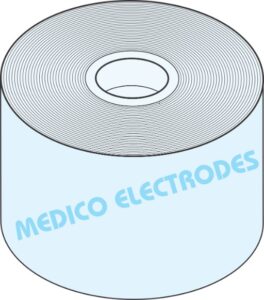The selection of electrode material is essential for achieving excellent signal quality and accurate and dependable electrocardiogram (ECG) measurements. Hydrogels have become the best option for ECG electrodes out of all the solutions available today, completely changing how we track heart activity. Let’s examine the reasons for these exceptional materials’ rise to prominence in ECG monitoring.

Knowing Hydrogels and How They Affect ECG Monitoring
Hydrogels are unique materials that are prepared with three-dimensional structures of hydrophilic polymers which, by their ability to absorb large quantities of water, possess characteristics intermediate between those of solids and liquids. Because of this particular characteristic, they are particularly suitable for use as ECG electrodes which essentially act as the link between the recording system and the skin. Creating a robust, conductive bridge that enables precise electrical signal transfer from the heart to the monitoring device is the main goal of ECG gel.
Excellent Signal Quality and Conductivity
The extraordinary electrical characteristics also play an important role in hydrogels’ success as electrodes for ECG measurements. ECG electrodes must have high water content in hydrogels to enable the collection of electrical impulses generated from the heart.
Because hydrogels maintain constant electrical contact with the skin’s surface, they successfully address the issues of poor skin contact and high impedance that plague traditional dry electrodes, which frequently result in poor signal quality.
Improved Comfort and Skin Compatibility
Comfort for the patient is crucial when monitoring an ECG, particularly when long-term recordings are being made. Even after prolonged use, hydrogels have exceptional biocompatibility with human skin, resulting in little discomfort. Hydrogel ECG electrodes’ soft, flexible texture enables them to follow the natural curves of the skin, ensuring steady contact even when the patient moves. This flexibility helps ensure more dependable signal acquisition in addition to enhancing patient comfort.
Stability and Retention of Moisture
Hydrogels retain their moisture level for longer than regular ECG gels, which can dry out fast. When electrode stability is essential during extended ECG monitoring sessions, this feature is especially helpful. Hydrogels’ capacity to retain water ensures constant conductivity during the recording time, eliminating signal artifacts brought on by inadequate electrode contact and lowering the requirement for frequent electrode replacement.
Properties of Adhesion and Simple Removal
The ideal balance between sufficient adhesion and gentle removal is achieved by contemporary hydrogel ECG electrodes. Even when patients are moving about or perspiring, the electrodes remain securely in place throughout monitoring thanks to the hydrogels’ adhesive qualities. Hydrogels, in contrast to certain conventional adhesive electrodes, can be withdrawn without causing pain or harm to the skin. Patients who need regular electrode replacements or have sensitive skin can especially benefit from this feature.
Resistance to Artifacts of Motion
In ECG monitoring, motion artifacts pose a serious problem that could jeopardize reading accuracy. Because of their special physical characteristics, hydrogels are excellent at reducing these artifacts. Hydrogel ECG electrodes’ viscoelastic properties allow them to accommodate little skin movements while preserving a steady electrical connection. Hydrogels are especially useful in situations involving stress testing and ambulatory ECG monitoring because of their resistance to motion artifacts.
Economically and Advantages of Storage
Hydrogel ECG electrodes may initially cost a little more than more conventional options, but over time, their longer use and better performance frequently translate into greater cost-effectiveness. When correctly handled, hydrogels retain their characteristics throughout storage, providing a longer shelf life than traditional ECG gels. When required, this stability guarantees consistent performance and minimizes waste.
Environmental Aspects
The biodegradability of medical materials has grown in importance in a time of growing environmental consciousness. With biodegradable components to lessen their environmental impact, many contemporary hydrogels used in ECG electrodes are made with environmental sustainability in mind. Their advantages over conventional electrode materials are further enhanced by this environmentally favorable feature.
Uses Not Just for Regular ECG Monitoring
Hydrogel ECG electrodes are useful for more than just standard heart monitoring. These materials have proven especially useful in specialized applications like athletic performance monitoring, where durability and motion resistance are critical, and neonatal care, where skin sensitivity is a critical concern. Hydrogels’ versatility enables customization to satisfy particular monitoring needs while preserving their primary advantages.
Upcoming Innovations and Developments
Hydrogel technology is still developing, with research being done to improve its quality for ECG applications. Smart hydrogels, which can react to changes in their surroundings and maybe provide even greater performance under a range of monitoring settings, are being developed as a result of advancements in polymer science. These developments should strengthen hydrogels’ standing as the material of choice for ECG electrodes.
Guaranteeing Peak Performance
Hydrogel ECG electrodes must be applied and maintained properly to optimize their effects. Before placing an electrode, healthcare professionals should make sure the skin is properly prepared. They should also adhere to the handling and storage instructions provided by the manufacturer. Although hydrogels have several benefits, proper use and storage conditions are ultimately what determine how successful they are.
Useful Advantages in Medical Environments
The useful benefits of hydrogel for ECG electrodes are further demonstrated in hectic clinical settings. Their simplicity of use, which reduces patient preparation time and boosts workflow efficiency, is valued by medical practitioners. The strain for medical personnel is lessened and data collection disruptions are minimized due to the decreased requirement for electrode replacement during long-term monitoring. Furthermore, more precise diagnosis and monitoring are made possible by the clear, constant signals produced by hydrogel electrodes, which may eliminate the need for repeated ECG recordings. Because of their clinical effectiveness and dependability, hydrogels are a vital component of contemporary cardiac care, helping patients and healthcare professionals get the best possible monitoring results.
Conclusion:
The wide range of advantages that hydrogels offer for ECG electrodes, from improved signal quality and patient comfort to useful advantages in long-term monitoring, clearly demonstrate their superiority. The use of hydrogels in ECG monitoring is anticipated to grow as medical technology develops further due to continuous advancements in material science and rising patient demands for dependable, user-friendly monitoring systems. They are a vital instrument in contemporary cardiac monitoring because of their special mix of qualities, which raises the bar for the caliber and dependability of ECG recordings. Hydrogel ECG electrodes continue to show why they are the best option for both patients and healthcare professionals, whether in situations involving routine examinations or ongoing monitoring.

